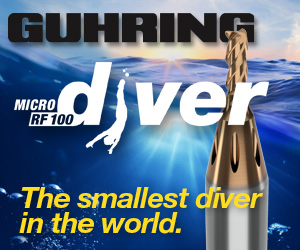 Ceratizit USA, in Warren, Michigan, exhibited at the Southtec trade show and showcased its full range cutting tools portfolio, including inch assortment, and hard materials solutions.
Ceratizit USA, in Warren, Michigan, exhibited at the Southtec trade show and showcased its full range cutting tools portfolio, including inch assortment, and hard materials solutions.
The company showcased its brands, including Cutting Solutions by Ceratizit, Komet, and WNT, and its premium turning tools, indexable and solid carbide milling, indexable and solid carbide drilling, and reamers, among others. For hard materials, Ceratizit displayed a range of solid carbide rods and preforms.
Highlights for hard materials include two new sustainable solutions, which includes the Exchangeable Head System (EHS) that offers maximum efficiency and economy with an exchangeable tool connection. The environmentally sound CTS20G end mill blanks incorporate a large concentration of high-quality secondary raw materials into a cutting tool grade and offer superb performance, the company says.
 According to Andy Newbery, national sales manager for Rods and Wear Parts, “Ceratizit continues to bring top innovative and quality solutions to the market. Both the EHS and CTS20G are great options for customers who are looking for sustainable and quality without any compromise in performance.”
According to Andy Newbery, national sales manager for Rods and Wear Parts, “Ceratizit continues to bring top innovative and quality solutions to the market. Both the EHS and CTS20G are great options for customers who are looking for sustainable and quality without any compromise in performance.”
Innovative tooling
Cutting tools highlights included the WTX-HFDS solid carbide drill, which is the first four-flute drill on the market, according to the company. Coated with Ceratizit’s proprietary Dragonskin coating, the drill achieves new levels of quality, hole tolerance, and positioning accuracy, with low burr formation while entering and exiting the hole. Additional tools included the CTPX710 and the CTPX715, the first multi-application insert grades from Ceratizit that machines steel, stainless steel, superalloys, and non-ferrous metals. Visitors also saw the KUB Quatron indexable drill, US-made solid carbide endmills, MaxiMill 491 indexable milling cutters, and FullMax high-performance reamers.
Related Glossary Terms
- burr
burr
Stringy portions of material formed on workpiece edges during machining. Often sharp. Can be removed with hand files, abrasive wheels or belts, wire wheels, abrasive-fiber brushes, waterjet equipment or other methods.
- gang cutting ( milling)
gang cutting ( milling)
Machining with several cutters mounted on a single arbor, generally for simultaneous cutting.
- milling
milling
Machining operation in which metal or other material is removed by applying power to a rotating cutter. In vertical milling, the cutting tool is mounted vertically on the spindle. In horizontal milling, the cutting tool is mounted horizontally, either directly on the spindle or on an arbor. Horizontal milling is further broken down into conventional milling, where the cutter rotates opposite the direction of feed, or “up” into the workpiece; and climb milling, where the cutter rotates in the direction of feed, or “down” into the workpiece. Milling operations include plane or surface milling, endmilling, facemilling, angle milling, form milling and profiling.
- milling machine ( mill)
milling machine ( mill)
Runs endmills and arbor-mounted milling cutters. Features include a head with a spindle that drives the cutters; a column, knee and table that provide motion in the three Cartesian axes; and a base that supports the components and houses the cutting-fluid pump and reservoir. The work is mounted on the table and fed into the rotating cutter or endmill to accomplish the milling steps; vertical milling machines also feed endmills into the work by means of a spindle-mounted quill. Models range from small manual machines to big bed-type and duplex mills. All take one of three basic forms: vertical, horizontal or convertible horizontal/vertical. Vertical machines may be knee-type (the table is mounted on a knee that can be elevated) or bed-type (the table is securely supported and only moves horizontally). In general, horizontal machines are bigger and more powerful, while vertical machines are lighter but more versatile and easier to set up and operate.
- sawing machine ( saw)
sawing machine ( saw)
Machine designed to use a serrated-tooth blade to cut metal or other material. Comes in a wide variety of styles but takes one of four basic forms: hacksaw (a simple, rugged machine that uses a reciprocating motion to part metal or other material); cold or circular saw (powers a circular blade that cuts structural materials); bandsaw (runs an endless band; the two basic types are cutoff and contour band machines, which cut intricate contours and shapes); and abrasive cutoff saw (similar in appearance to the cold saw, but uses an abrasive disc that rotates at high speeds rather than a blade with serrated teeth).
- superalloys
superalloys
Tough, difficult-to-machine alloys; includes Hastelloy, Inconel and Monel. Many are nickel-base metals.
- tolerance
tolerance
Minimum and maximum amount a workpiece dimension is allowed to vary from a set standard and still be acceptable.
- turning
turning
Workpiece is held in a chuck, mounted on a face plate or secured between centers and rotated while a cutting tool, normally a single-point tool, is fed into it along its periphery or across its end or face. Takes the form of straight turning (cutting along the periphery of the workpiece); taper turning (creating a taper); step turning (turning different-size diameters on the same work); chamfering (beveling an edge or shoulder); facing (cutting on an end); turning threads (usually external but can be internal); roughing (high-volume metal removal); and finishing (final light cuts). Performed on lathes, turning centers, chucking machines, automatic screw machines and similar machines.





